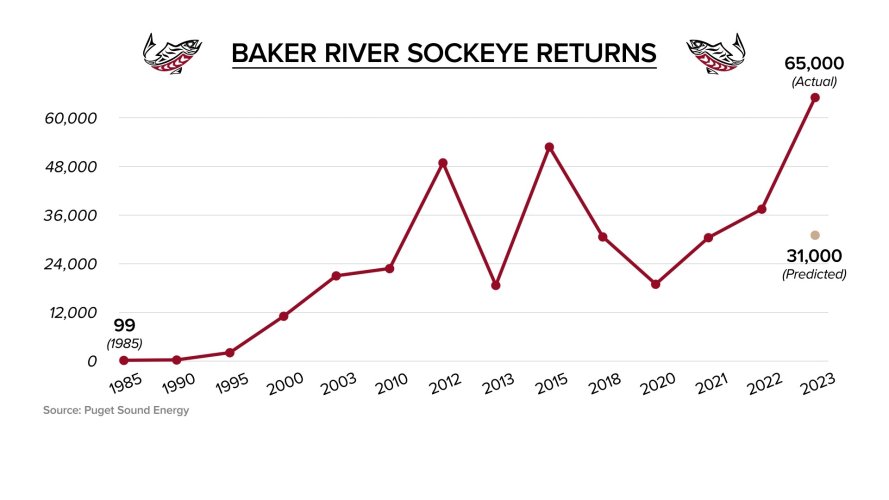Did they happen to release a similar study for total salmonid counts and/or kings? Very interested in that data set if it’s available.Two studies (attached) from the Elwha River that document steelhead occurrence since dam removal.
View attachment 300008
View attachment 300009
Navigation
Install the app
How to install the app on iOS
Follow along with the video below to see how to install our site as a web app on your home screen.
Note: This feature may not be available in some browsers.
More options
You are using an out of date browser. It may not display this or other websites correctly.
You should upgrade or use an alternative browser.
You should upgrade or use an alternative browser.
West coast salmon recovery
- Thread starter Irrelevant
- Start date
atlas
Well-known member
- Joined
- Feb 15, 2022
- Messages
- 345
How much of this was due to hatchery contributions, and how much to improved fish passage?
Goodfish
Well-known member
I like the heat that Seattle City Light is getting because of it for not having fish ladders on their 3 dams. It seems like the sockeye deal with fish ladders well especially with hatchery augmentation.How much of this was due to hatchery contributions, and how much to improved fish passage?
Irrelevant
Well-known member

‘Killing salmon to lose money’: A costly, questionable plan on the Willamette
The U.S. Army Corps of Engineer has ruled out opening Willamette River dams and letting fish coast the natural current to help improve survival numbers. It would cost next to nothing and has worked before. The Corps says a costly fish collection machine is the only way to save salmon without...
www.opb.org
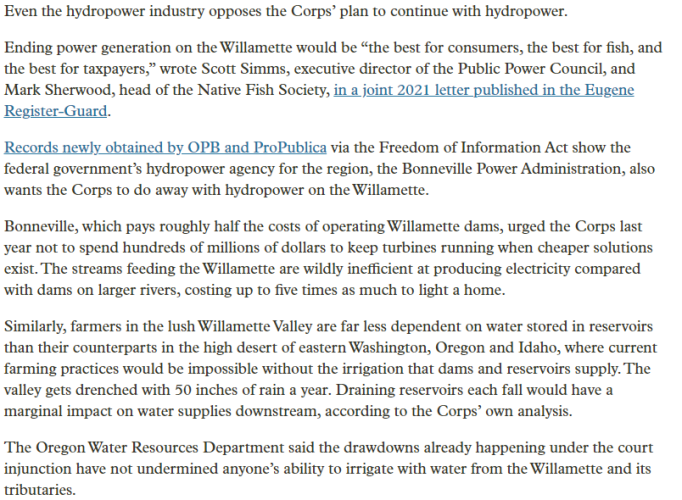
Irrelevant
Well-known member

Chelan County PUD's Rocky Reach Dam sees 93.78% juvenile Chinook survival rate — highest in 20 years
WENATCHEE — Results from a month-long Habitat Conservation Plan (HCP) Confirmation Survival Study at Rocky Reach Dam were better than expected this year — with a 93.78% survival rate for
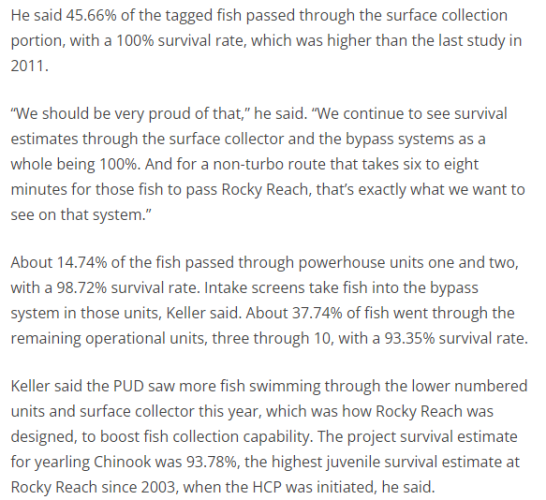
Goodfish
Well-known member
It would seem that the Corps could learn a lot from Chelan PUD! Any solution that calls for hundreds of millions of dollars for a system that requires perpetual trucking and pumping just seems like a no brainer to eliminate, especially when the bulk of the beneficiaries seem to not want them. Dams with no fish ladders should be on the top of the expenditure list for either ladders or dam removal. Draw downs during the outbound migrations have to be part of the plan.View attachment 302726
‘Killing salmon to lose money’: A costly, questionable plan on the Willamette
The U.S. Army Corps of Engineer has ruled out opening Willamette River dams and letting fish coast the natural current to help improve survival numbers. It would cost next to nothing and has worked before. The Corps says a costly fish collection machine is the only way to save salmon without...www.opb.org
44hunter45
Well-known member
Still trying to digest this. Got the link in a letter from Idaho Wildlife Federation. The source .ORG gives me pause, but it's legit.
Part of me says, "Let's go Brandon" and part of me says, " Let's go salmon."
Part of me says, "Let's go Brandon" and part of me says, " Let's go salmon."
Goodfish
Well-known member
This one is interesting. The tribes have been working on energy independence projects to advocate for removing the 4 lower dams. Good on them for a positive move. I’d still like to see the logic for removing the 4 lower dams compared to the benefit of removing the end of line dams like the 3 Hells Canyon complex dams and Grand Coulee. That said I’d love to see the return of the upland bird hunting country in the lower Snake If the dams are removed. Likely none of this happens in my lifetime but maybe I’ll be watching somehow!Still trying to digest this. Got the link in a letter from Idaho Wildlife Federation. The source .ORG gives me pause, but it's legit.
Part of me says, "Let's go Brandon" and part of me says, " Let's go salmon."
44hunter45
Well-known member
Not sure how I missed this. My son who lives on the Alsea mentioned this to me this morning before he headed home to Oregon.
Saving Washington's salmon from toxic tire dust
After researchers pinpointed the toxic chemical that is killing coho salmon in freshwater, we got to work, alongside several partners, to protect coho salmon.ecology.wa.gov
Solving a pollution problem that is happening every day, on every roadway, from millions upon millions of motor vehicles, requires coordination across state and federal regulatory agencies, tribal governments, industry, research universities and institutions, and interest groups.
We established a forum for these groups to work together to expedite sharing research and new ideas. We are funding research at academic institutions to learn more about 6PPD replacement chemicals and their toxic impact on salmon and other aquatic species. We are also coordinating with tire and chemical manufacturers to better understand 6PPD so that we can make knowledgeable decisions on finding a chemical to replace 6PPD in tires.
Controlling the source of pollution is the most effective way to prevent 6PPD-quinone from entering the environment; however, it will take many years to develop tires that don’t contain 6PPD and never release 6PPD-quinone into the environment.
In the meantime, we will continue monitoring 6PPD-quinone in the environment and will provide guidance and funding to treat stormwater before it enters waterways. Our goal is to lessen the toxic effects of 6PPD-quinone until we can find a safer replacement.
I guess I don't understand why this isn't considered a "taking" of an ESA listed species? I mean there is no way that Ecology chemists are going to be quicker to a solution than chemists for Goodyear. I'd fine them, with a progressive scale to "incentivize" them to find better alternatives. I mean this correlation was first announced in 2018 https://pubs.acs.org/doi/10.1021/acs.est.8b03287
We banned DDT, WTF can't we just ban this stuff? Give the tire companies x number of months to find a solution.
44hunter45
Well-known member
Here is where you can write to the EPA about getting serious on 6PPD.
FI460
Well-known member

Fourth dam breached on the Klamath River
Video of the event shows a small explosion at the foot of the century old, 120-foot tall cement dam, followed by a plume of brown water being released downriver.
www.opb.org
Still surreal that it's actually happening. Everyone in Siskiyou county seems to be very upset that previous lake bed is muddy. I'm not sure what they expected.
Salmonchaser
Well-known member
- Joined
- Nov 12, 2019
- Messages
- 2,125
Well they’ll be happy next year. Should grow grass like crazy.
Irrelevant
Well-known member
Let's hope the salmon return at a better rate on the Klamath than they have on the Elwha and White Salmon rivers.
atlas
Well-known member
- Joined
- Feb 15, 2022
- Messages
- 345
If there isn't a big response in the salmon numbers in the Klamath, I think it will really hurt prospects for the Snake River dams.
Goodfish
Well-known member
I think everyone needs to be realistic about the math. Some of the species in the Elwha are doing well. Chinook populations are down globally including Alaska and Canada so judging the success of dam removal by only exponential increases in population is unrealistic especially on a three to five year life cycle to return when they spend the vast majority of their life in the open ocean thousands of miles away. We can’t expect 1000% increases as much as we would like them. When they speak of 100% increases remember that it’s 1500 fish increasing to 3000 fish over that 4 years. It’s not going to suddenly pop back to 60,000 fish. There are a lot of other metrics of river health. The growth of the estuary at the mouth of the Elwha is absolutely amazing! It’s a much healthier place there than when I was a kid.
atlas
Well-known member
- Joined
- Feb 15, 2022
- Messages
- 345
I think everyone needs to be realistic about the math. Some of the species in the Elwha are doing well. Chinook populations are down globally including Alaska and Canada so judging the success of dam removal by only exponential increases in population is unrealistic especially on a three to five year life cycle to return when they spend the vast majority of their life in the open ocean thousands of miles away. We can’t expect 1000% increases as much as we would like them. When they speak of 100% increases remember that it’s 1500 fish increasing to 3000 fish over that 4 years. It’s not going to suddenly pop back to 60,000 fish. There are a lot of other metrics of river health. The growth of the estuary at the mouth of the Elwha is absolutely amazing! It’s a much healthier place there than when I was a kid.
Goodfish
Well-known member
That’s good stuff!Watched this the other day. Coho and steelhead are doing great. It could take 15 years before the full effects of dam removal are realized. All that sediment was a shock to the river and there were several times it far surpassed the lethal threshold for suspended sediment. Now it's in a far better place.
FI460
Well-known member
Watched this the other day. Coho and steelhead are doing great. It could take 15 years before the full effects of dam removal are realized. All that sediment was a shock to the river and there were several times it far surpassed the lethal threshold for suspended sediment. Now it's in a far better place.
The sediment is one of the things that has everyone tore up here. The Klamath does look admittedly gross, but I'm not sure what folks expected it to look like.
This is where Clear Creek meets the Klamath. Maybe 70 miles downstream of the dams.
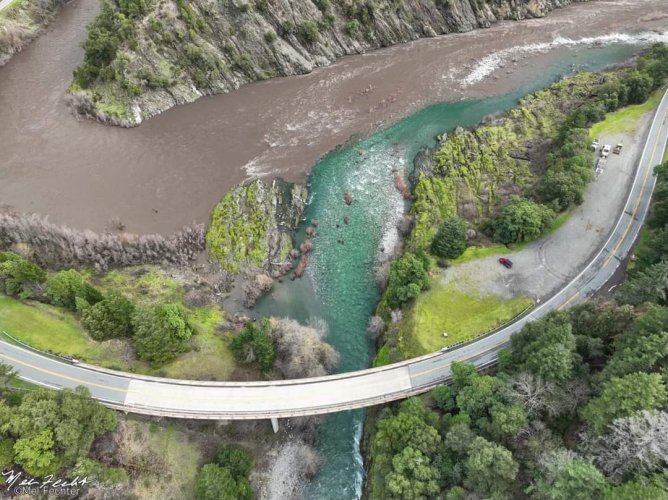
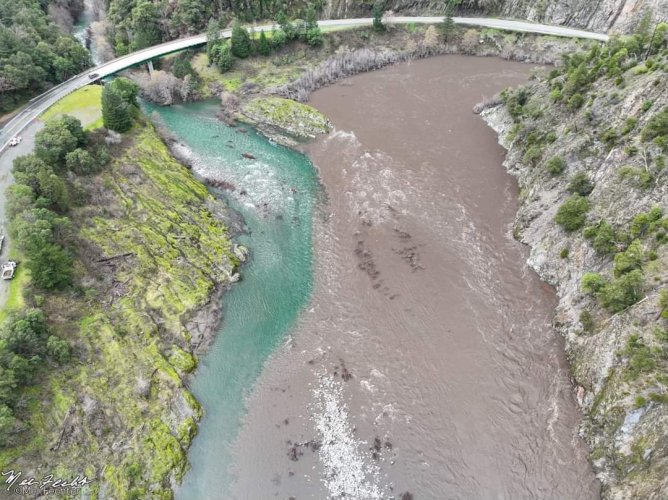
Goodfish
Well-known member
The other thing to be realistic about is that removing the dam makes the river healthier and better able to support and produce fish. If the fish are dying at sea through starvation, predation, fishing, and bycatch then it will take much longer yet to recover. When the Chinook populations in the Kenai, Kasilof, Yukon, Kuskoquim, Bristol Bay and Canadian Rivers all decline hugely at the same time Sockeye and Pink Salmon numbers are increasing enormously there there is something else much bigger happening. The dam removals make the river more able to produce the fish once the fish are actually able to make it back to their home river. No telling when that will be but unfortunately along the West Coast (especially Washington) it is going to get worse before it gets better due to politics.
Similar threads
- Replies
- 26
- Views
- 4K
- Replies
- 10
- Views
- 1K




